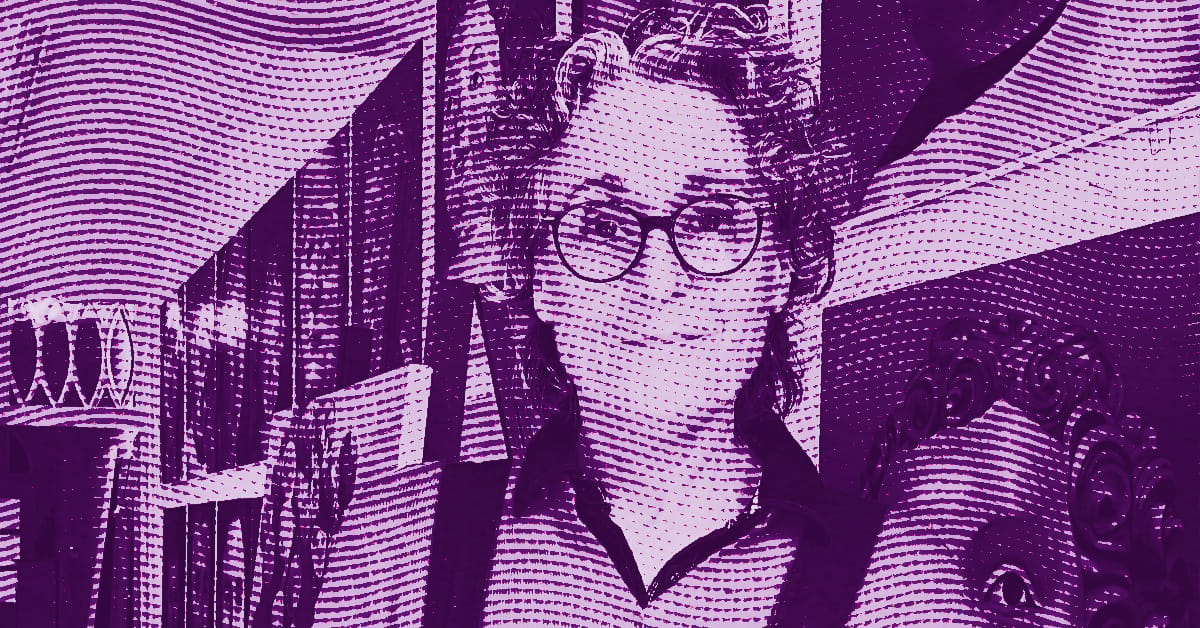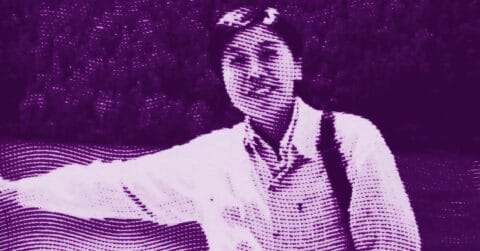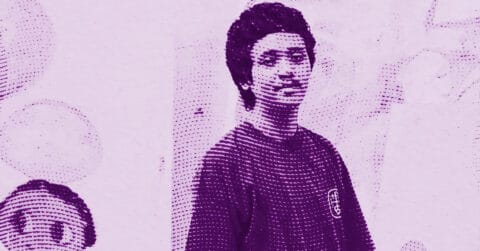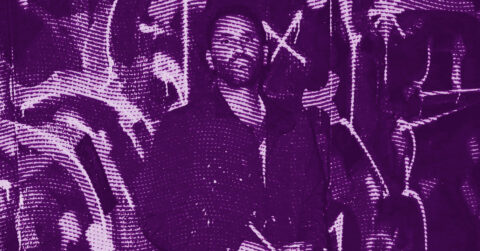Listen to me carefully, you bunch of snobs: if you are still looking for certainties in contemporary art, move along. Karin Kneffel is not here to comfort you with reassuring truths about what you think you see. This 68-year-old woman, a former student of Gerhard Richter, has spent the last four decades building a pictorial corpus that acts like a slow poison against our visual habits. Her hyperrealistic paintings are not windows onto the world, but distorting mirrors that reflect back to us the image of our own inability to distinguish the authentic from the fake.
“My interest in creating art is to produce a feeling of doubt, something I have not yet really grasped” [1]. This statement by the artist resonates like a manifesto. Kneffel does not paint to reveal, but to disturb. Her compositions are “perfectly constructed impossibilities” that collapse “heterogeneous places and incidents” [1]. Here is a painter who fully assumes the fictive nature of her medium while exploiting its representational power. This tension constitutes the neural core of her work.
The architecture of the gaze
Kneffel’s work maintains a complex relationship with modern architecture, particularly visible in her interventions on the works of Ludwig Mies van der Rohe. In 2009-2010, during the exhibition “House on the Edge of Town” at the Haus Esters Museum in Krefeld, she took hold of the modernist villas designed by the architect to question the persistence of the past in the present. These buildings, conceived according to the principles of transparency and rationality, become under her brush spaces of stratified memory where different temporalities overlap.
Kneffel’s approach to the modernist heritage reveals a remarkable critical intelligence. Rather than giving in to nostalgia or easy denunciation, she chooses to paint “an image of an image of the image we experience today” [2]. This method of visual mise en abyme connects with contemporary architecture’s concerns regarding the reinterpretation of historical models.
The thirteen paintings of this series transform Mies van der Rohe’s spaces into theaters of ambiguity. Kneffel deploys her characteristic technique of reflections and wet surfaces to blur the boundaries between interior and exterior, between past and present. This pictorial strategy finds a direct echo in Mies’s architectural philosophy, who himself sought to dissolve the traditional limits of domestic space. However, whereas the architect aimed for clarity and purity, the painter introduces confusion and doubt.
The 2014 installation at the Mies van der Rohe Pavilion in Barcelona pushes this logic to its extreme. By placing one of her canvases opposite the pavilion’s glass roof, Kneffel creates a device where the architecture becomes complicit in the pictorial illusion. The viewer is caught in a game of multiple reflections where the reality of the building merges with the fictions of the painting. This intervention goes beyond mere exhibition to become a reflection on the nature of architectural perception itself.
The artist understands that modern architecture, with its claim to pure functionality, does not escape symbolic constructions. Her paintings reveal the psychological and emotional dimensions that modernist spaces try to repress. By painting period interiors with their furniture and works of art, she exposes the contradictions between the modernist ideal and the bourgeois reality of its patrons.
This investigation of architectural space is coupled with a reflection on the status of art within the domestic space. Kneffel paints works by Chagall, Kirchner, or Macke as they appeared in the Lange and Esters houses, then follows them to their current museum locations. This “visual archaeology” reveals how the displacement of the works alters their meaning and aesthetic impact.
The recurring use of reflective surfaces in these compositions is not merely decorative. It constitutes a metaphor for the modern condition, where we continuously see images of images. Mies van der Rohe’s glass architecture, designed to reveal and unify, becomes with Kneffel the symbol of an era where transparency hides as much as it reveals.
The psychoanalysis of the everyday
Beyond her architectural explorations, Kneffel’s work reveals a deep understanding of the psychic mechanisms that govern our relationship with objects and domestic spaces. Her monumental still lifes and interior scenes function as echo chambers of the collective unconscious, where the desires and anxieties of contemporary bourgeois society crystallize.
The artist admits without hesitation: she does not use “color, oil paint, in a naive way” [2]. This technical awareness is paired with psychological lucidity. Kneffel knows that her oversized fruits, her animals with too human a gaze, and her slick interiors awaken sentimental structures buried within us. She deliberately plays on the boundary separating authentic emotion from kitsch, this “trademark” that “appeals to the sentimental structures lying dormant in each of us” [3].
Her animal portraits from the 1990s perfectly illustrate this strategy of emotional ambivalence. These creatures stare at us with “their gaping eyes, widely flared nostrils, drooping ears, almost sneering” [3]. The effect is striking: we project a humanity onto these animal faces that unsettles us. The viewer is caught in a mechanism of projection and withdrawal that reveals the fragility of our perceptual certainties.
This investigation of projective mechanisms finds its fulfillment in the artist’s recent interiors. The domestic spaces she paints function as projection screens for our fantasies of comfort and security. But these interiors are always seen through a fogged glass, behind drops of water or parasitic reflections that transform the familiar space into a disturbing territory.
The recurrent use of the window motif in her work is not a coincidence. The window, this “eye of the house” according to the established expression, becomes for Kneffel the place of an inquiry into the boundaries between the intimate and the public, between the inside and the outside. But unlike the pictorial tradition that makes the window a transparent frame on the world, she turns it into a distorting filter that reveals the impossibility of a neutral gaze.
Her recent compositions with cleaning women introduce a social dimension into this psychoanalysis of the domestic sphere. These figures, often borrowed from Hitchcock’s or Billy Wilder’s cinema, embody the repressed part of bourgeois comfort. They remind us that the domestic order relies on invisible work, generally female, that maintains the illusion of the spontaneity of well-being.
The artist develops a true “poetics of suspicion” that reveals the unconscious dimensions of our relationship to objects. Her still lifes do not celebrate abundance or beauty but question our compulsive need for visual consumption. The fruits she paints are “too real” to be true, their surfaces too perfect not to arouse suspicion.
This psychoanalytic approach to everyday life finds its theoretical justification in Kneffel’s attention to the processes of perception. She understands that “we cannot see any thing as it is, we always see the representation we have of things” [4]. This lucidity leads her to construct images that expose our perceptual mechanisms rather than comfort them.
The systematic use of equal focus in her compositions disrupts our visual habits. In reality, our eye constantly focuses, creating a hierarchy between planes. By painting everything with the same sharpness, Kneffel creates an “imaginary” space where “present and history can merge” [4]. This technique reveals the constructed nature of our perception and its anchoring in determined cultural schemes.
The politics of the image
Kneffel’s work flourishes in a post-Cold War context where ideological certainties crumble in favor of a generalized image society. Her work can be read as an artistic response to the transformations of the German and European public space since reunification. By choosing to paint bourgeois interiors and consumer objects, she questions the new power relations emerging in a surface-peaceful society.
The artist’s hyperrealistic technique is not just a matter of technical virtuosity. It constitutes an aesthetic and political stance in a world saturated with digital images. Faced with the progressive dematerialization of artistic production, Kneffel claims slowness and the materiality of oil painting. Each canvas demands months of work; every detail is conquered against the ease of digital.
This resistance through slowness takes on a political dimension when considering the context of production of her works. Trained in West Germany in the 1980s, Kneffel belongs to a generation that experienced the fall of the Berlin Wall and unification. Her interior paintings can be read as a meditation on German identity under reconstruction, between modern heritage and contemporary realities.
Her attention to everyday objects reveals a sharp awareness of ongoing social changes. Her still lifes do not show luxury products or symbols of power but the fruits, furniture, and pets that compose the middle-class environment. This democracy of the painted object reflects an egalitarian vision of art that rejects traditional hierarchies between noble and trivial.
Her work on the modernist architectures of Mies van der Rohe can also be interpreted as a reflection on the political legacy of modernity. By showing how these utopian spaces have become museums, she reveals the relative failure of the modern project of social transformation through architecture. Her paintings expose the gap between the revolutionary ambitions of the avant-gardes and their current museum recuperation.
The recurring use of the voyeur figure in her compositions introduces a critical dimension on contemporary surveillance society. By systematically placing us in the position of indiscreet observers, she reveals our complicity with mechanisms of social control. Her fogged windows and reflective surfaces evoke the surveillance screens that populate contemporary urban space.
The question of gender also subtly but persistently runs through her work. Trained in a male-dominated artistic environment, she had to assert her themes against the prejudices of the time. “At that time, the academy considered that such and such a subject should not be painted. Fruits or animals, for example. Too decorative, thus even more inappropriate for a woman” [4]. This resistance to gendered prohibitions permeates her entire oeuvre.
The mechanics of doubt
After four decades of creation, Kneffel has developed a true machine for producing uncertainty. Her latest works, notably the series “Face of a Woman, Head of a Child” from 2021-2022, reveal a technical and conceptual mastery that places her art among the greatest. These dozens of diptychs on the theme of mother and child mark a turning point in her production by introducing for the first time the human figure at the center of her concerns.
These portraits, derived from polychrome sculptures of the Northern Renaissance, perform a radical secularization of Christian iconography. By removing halos, veils and other religious attributes, Kneffel “transforms the models into highly subjective objects, endowed with a vitality animated thanks to the pictorial contour and color” [5]. This secularization reveals the persistence of archetypal structures in contemporary art.
The diptych technique proves particularly effective in creating the effect of doubt sought by the artist. By separating mother and child on two distinct canvases, she breaks the traditional unity of the sacred group while preserving their bond through physiognomic resemblance. This fragmentation generates an emotional tension that disrupts our iconographic habits.
The inclusion of her self-portrait with her son in this series introduces a new autobiographical dimension to her work. This intrusion of the personal into the corpus reveals an evolution of the artist towards an acceptance of subjectivity. The fact that she paints these works at the moment she becomes a grandmother adds a temporal resonance that enriches the reading of the whole.
The technical mastery achieved in these latest works borders on a marvel. Kneffel manages to render the texture of the painted wood of the original sculptures while maintaining the fluidity of oil painting. This feat reveals a deep understanding of the issues of translation between mediums. She does not paint sculptures, but the idea of sculpture as it can exist in painting.
The choice to work from photographs rather than from nature introduces an additional mediation that enriches the reflection on the image. “Photographs are the ambivalent originals on which most of her paintings are based” [6]. This ambivalence is precisely the artist’s playground. She transforms the imperfection of the photographic medium into a creative strength.
Kneffel’s technical evolution reveals a fascinating paradox: the more she masters her craft, the more her works become complex and difficult to execute. “I become faster, but at the same time my canvases require more time” [4]. This apparent contradiction reflects an artistic ambition that only grows with age. Far from simplifying, her art densifies and stratifies.
This increasing complexity is accompanied by a keen awareness of the pictorial heritage. Kneffel constantly dialogues with the history of painting, from Northern Renaissance to American pop art. But this dialogue never falls into gratuitous citation or complacent pastiche. She uses history as a reservoir of aesthetic problems to solve rather than as a museum to visit.
Kneffel’s art confronts us with a disturbing truth: we no longer know how to see. Accustomed to digital image flows, we have lost the sustained attention that painting demands. Her hyperrealistic canvases force us to slow down, scrutinize, and doubt our first impressions. They serve as visual rehabilitation exercises in a world of rushed blind people.
Her international commercial and critical success, crowned by her representation at Gagosian since 2012, testifies to the relevance of this approach. In an art market dominated by immediacy and spectacularization, Kneffel offers an alternative based on contemplation and introspection. Her works, sold for several hundreds of thousands of euros, prove that there still exists an audience for demanding art.
The eye and the hand
Karin Kneffel teaches us a fundamental lesson: art should not reassure but question, not comfort but disturb. Her work constitutes a valuable antidote against lazy fascination and passive image consumption. By transforming doubt into a creative method, she opens new perspectives for contemporary painting.
Her artistic trajectory testifies to remarkable obstinacy. Trained in the wake of Gerhard Richter, she has succeeded in developing an autonomous pictorial language which, without denying the modern heritage, invents its own plastic solutions. This aesthetic independence deserves to be praised in an artistic environment often subject to fashion effects and commercial pressures.
The scope of the corpus built over forty years definitively places Kneffel among the major figures of contemporary European painting. Her works, present in the largest international collections, will continue to nourish reflections on image and perception for a long time. They constitute a unique testimony on the transformations of Western society since the end of the Cold War.
The artist’s pedagogical commitment, who trained generations of students in Bremen and then in Munich, ensures the transmission of her approach. This professorial dimension reveals a conception of art as a discipline requiring rigor and perseverance. In an era that favors permanent innovation, Kneffel defends the virtues of deepening and slow maturation.
Her art ultimately reminds us that painting retains unique expressive resources that new media cannot match. The materiality of the paste, the slowness of execution, the physical presence of the work create irreplaceable conditions of reception. By persisting in this path against all odds, Kneffel keeps alive a millennial tradition while updating it for our time.
In a world rushing towards digital abstraction and artificial intelligence, Karin Kneffel’s work serves as a salutary reminder of the irreducible specificity of the human aesthetic experience. Her painted doubts help us to rediscover our own capacity for questioning. And perhaps this is her greatest victory: having transformed uncertainty into creative certainty.
- Gagosian Gallery, “About Karin Kneffel”, Gagosian gallery website, accessed in 2025
- Sunil Manghani, “On situating painting: An interview with Karin Kneffel”, Journal of Contemporary Painting, Volume 3, Numbers 1 & 2, 2017
- Noemi Smolik, “Karin Kneffel”, Artforum, translated from German by Joachim Neugroschel
- Anke Brack, “Karin Kneffel: ‘Meine Bilder haben sich gut gehalten'”, Neue Zürcher Zeitung, November 28, 2020
- Mousse Magazine, “Karin Kneffel ‘Face of a Woman, Head of a Child’ at Gagosian, Rome”, October 26, 2022
- Gagosian Quarterly, “The Actual Picture: On Karin Kneffel’s Painting”, October 2022
















